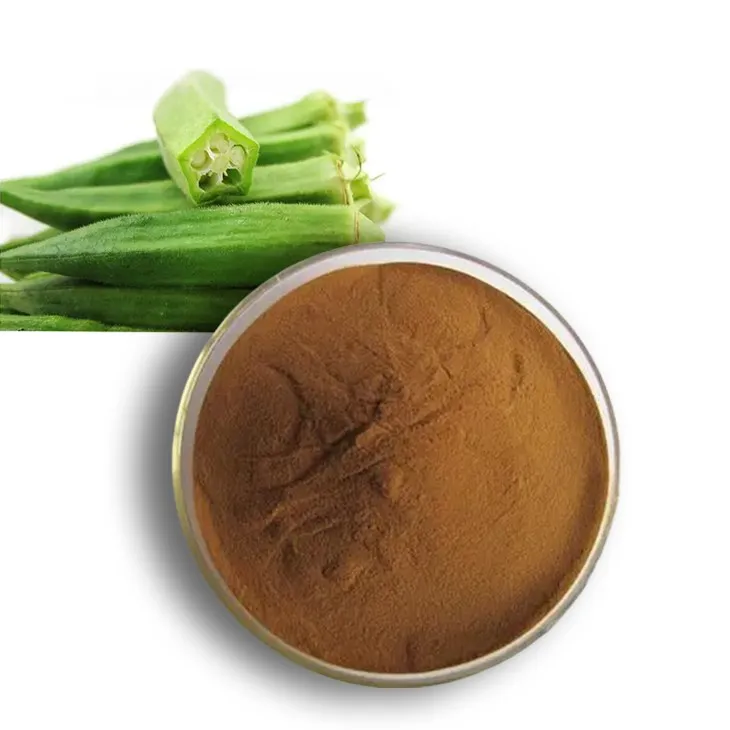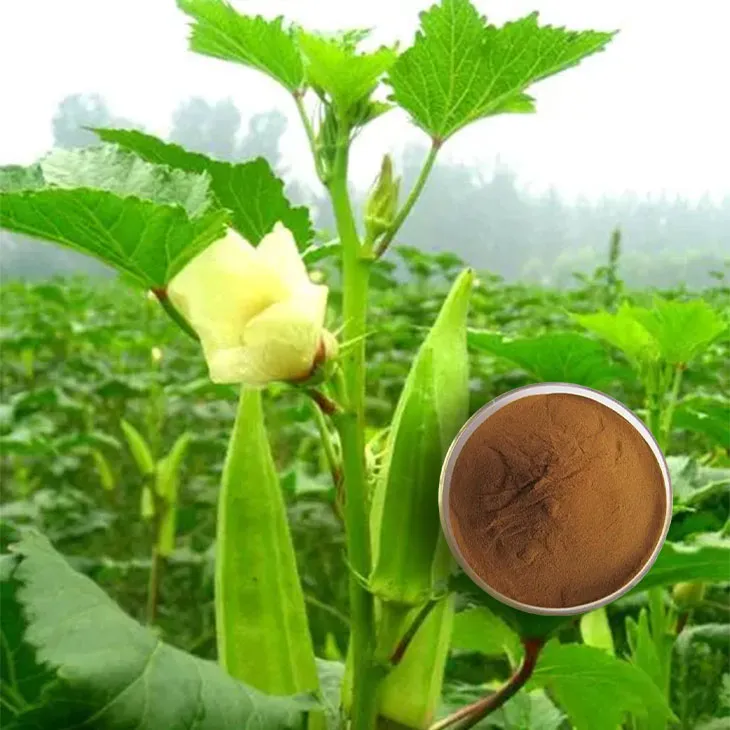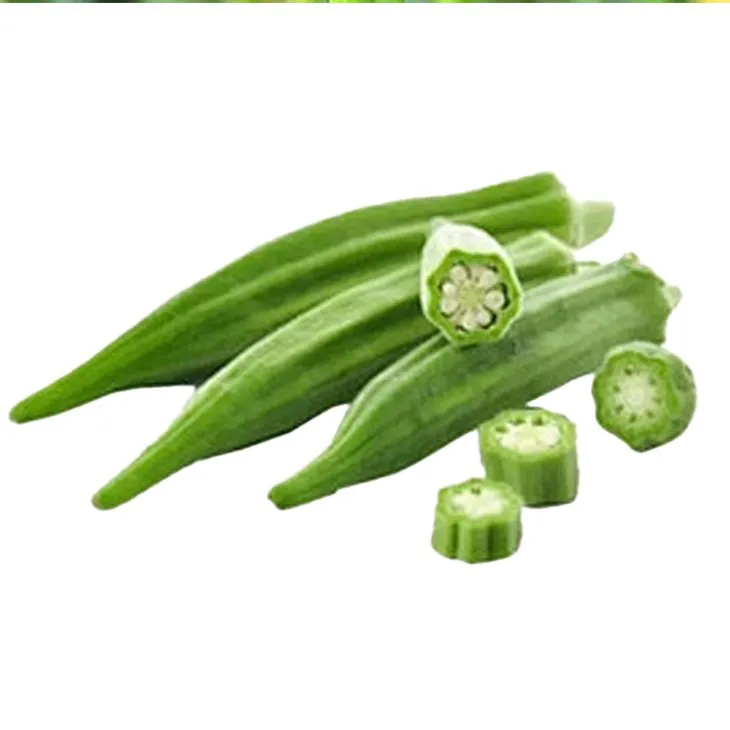- 0086-571-85302990
- sales@greenskybio.com
The process of extracting okra mucin from okra extract.
2024-11-28

1. Introduction
Okra, a popular vegetable known for its unique texture and nutritional value, contains a substance called okra mucin. Okra mucin has attracted significant attention in recent years due to its potential applications in various fields, such as food, medicine, and cosmetics. Extracting okra mucin from Okra Extract is a complex but interesting process that involves multiple steps and techniques. This article will delve into the in - depth process of extracting okra mucin, including raw material preparation, extraction techniques, and potential applications of the extracted protein.

2. Raw Material Preparation
2.1 Selection of Okra
The first step in preparing the raw material for okra mucin extraction is the careful selection of okra. High - quality okra should be chosen. Freshness is a crucial factor. Okra that is free from bruises, pests, and diseases is preferred. Mature but not overripe okra is often considered ideal as it contains an appropriate amount of mucin. The size and shape of the okra can also play a role. Uniform - sized okra may be easier to process in subsequent steps.
2.2 Cleaning and Sanitization
Once the okra is selected, it needs to be thoroughly cleaned and sanitized. The okra is washed under running water to remove any dirt, soil, or debris adhered to its surface. This step is essential to prevent contamination of the final extract. In some cases, a mild detergent solution may be used for more effective cleaning, followed by rinsing with clean water to ensure that no detergent residue remains. Sanitization can also be carried out using food - grade sanitizers to kill any potential microorganisms on the surface of the okra.
2.3 Drying and Storage
After cleaning, the okra may be dried. Drying can be achieved through natural drying in a well - ventilated area or using artificial drying methods such as dehydrators. The dried okra should be stored in a cool, dry place to maintain its quality until it is ready for extraction. Proper storage conditions are important to prevent spoilage and ensure the stability of the okra's components, including the mucin.

3. Extraction Techniques
3.1 Solvent Extraction
- One of the common methods for extracting okra mucin is solvent extraction. In this method, a suitable solvent is selected. Water is often a primary choice as it is a natural and safe solvent. However, other solvents such as ethanol or acetone may also be used depending on the specific requirements of the extraction process.
- The dried okra is then ground into a fine powder. This increases the surface area available for extraction, allowing the solvent to interact more effectively with the mucin present in the okra.
- The powdered okra is mixed with the solvent in a specific ratio. For example, a ratio of 1:10 (okra powder to solvent) may be used. The mixture is then stirred continuously for a certain period, usually several hours. This agitation helps in the dissolution of the mucin into the solvent.
- After stirring, the mixture is filtered. Filtration can be carried out using filter papers or other filtration devices. The filtrate contains the dissolved okra mucin, while the residue consists of undissolved plant materials.
3.2 Enzyme - Assisted Extraction
- Enzyme - assisted extraction is another technique that can be used for okra mucin extraction. Enzymes can be used to break down the cell walls of the okra more effectively, facilitating the release of mucin. Commonly used enzymes include cellulases and pectinases.
- The okra is first treated with the enzyme solution. The enzyme concentration, temperature, and pH need to be carefully controlled. For example, a cellulase concentration of 0.5 - 1.0% (w/v), a temperature of around 40 - 50°C, and a pH of 4.5 - 5.5 may be optimal for the enzymatic reaction.
- The reaction is allowed to proceed for a specific time period, usually 1 - 3 hours. During this time, the enzymes break down the cell walls and release the mucin into the solution.
- After the enzymatic reaction, the solution is heated to inactivate the enzymes. This is usually done at a temperature above 80°C for a few minutes. Then, the solution is filtered to obtain the okra mucin - containing filtrate.
3.3 Ultrasonic - Assisted Extraction
- Ultrasonic - assisted extraction is a relatively new and efficient method. Ultrasonic waves are applied to the Okra Extract. The ultrasonic waves create cavitation bubbles in the solution.
- These cavitation bubbles collapse, generating high - pressure and high - temperature micro - environments. These extreme conditions help in breaking down the cell structures of the okra and releasing the mucin.
- The okra is placed in a solvent, and the ultrasonic treatment is carried out for a specific duration, typically 15 - 30 minutes. The frequency and power of the ultrasonic waves also need to be optimized. For example, a frequency of 20 - 50 kHz and a power of 200 - 500 W may be suitable.
- After the ultrasonic treatment, the solution is filtered to obtain the okra mucin - rich filtrate.

4. Purification of the Extracted Okra Mucin
4.1 Precipitation
- Once the okra mucin is extracted, it often needs to be purified. Precipitation is a common purification method. In this method, a precipitating agent is added to the filtrate containing the okra mucin. For example, ammonium sulfate can be used as a precipitating agent.
- The precipitating agent is added gradually until a certain saturation level is reached. As the saturation level increases, the okra mucin begins to precipitate out of the solution.
- The precipitated okra mucin is then collected by centrifugation. The centrifugation speed and time are important parameters. For example, a centrifugation speed of 5000 - 10000 rpm for 10 - 20 minutes can be used to separate the precipitated mucin from the supernatant.
4.2 Dialysis
- Dialysis is another purification technique. The precipitated okra mucin is dissolved in a suitable buffer solution. The solution is then placed in a dialysis membrane.
- The dialysis membrane allows small molecules such as salts and impurities to pass through while retaining the larger okra mucin molecules. The dialysis process is carried out for a certain period, usually several hours to overnight, with continuous stirring or circulation of the solution inside the dialysis membrane.
- This helps in removing any remaining small - molecule impurities from the okra mucin solution, further purifying the mucin.
5. Characterization of the Extracted Okra Mucin
5.1 Physical Characterization
- Physical characterization of the extracted okra mucin is important to understand its properties. One aspect of physical characterization is the determination of its viscosity. Viscosity can be measured using a viscometer. The viscosity of okra mucin can vary depending on factors such as concentration, temperature, and pH.
- Another physical property is its solubility. Okra mucin may have different solubility characteristics in different solvents. Understanding its solubility can help in further processing and application development.
- The appearance of the okra mucin, such as its color and transparency, can also be observed. A pure okra mucin extract may be colorless or slightly yellowish and relatively transparent.
5.2 Chemical Characterization
- Chemical characterization involves analyzing the chemical composition of the okra mucin. One important analysis is the determination of its protein content. Protein content can be measured using methods such as the Bradford assay or Kjeldahl method.
- The presence of specific amino acids in the okra mucin can also be determined. This can be done using techniques such as amino acid analysis by high - performance liquid chromatography (HPLC).
- Analysis of the carbohydrate content in okra mucin is also necessary as mucin is a glycoprotein. Carbohydrate analysis methods such as the phenol - sulfuric acid method can be used.
6. Potential Applications of the Extracted Okra Mucin
6.1 Food Industry
- In the food industry, okra mucin can be used as a thickening agent. It has the ability to increase the viscosity of food products such as soups, sauces, and dressings. This can improve the texture and mouthfeel of these products.
- Okra mucin can also act as a stabilizer. For example, in dairy products like ice cream, it can prevent ice crystal formation and improve the stability of the emulsion.
- As a dietary fiber, okra mucin can contribute to the nutritional value of food products. It can help in promoting digestive health and reducing the risk of certain diseases.
6.2 Pharmaceutical Industry
- In the pharmaceutical industry, okra mucin has potential applications in drug delivery systems. Its unique properties, such as its ability to form gels, can be utilized to encapsulate drugs and control their release. This can improve the efficacy and safety of drug delivery.
- Okra mucin may also have anti - inflammatory properties. It can be used in the development of anti - inflammatory drugs or as an ingredient in topical formulations for treating skin inflammations.
- Due to its mucoadhesive properties, okra mucin can adhere to mucosal surfaces in the body. This makes it suitable for developing formulations for oral, nasal, or vaginal drug delivery.
6.3 Cosmetics Industry
- In the cosmetics industry, okra mucin can be used as a moisturizer. It can form a thin film on the skin, preventing water loss and keeping the skin hydrated.
- It can also be used as a thickening and emulsifying agent in cosmetic products such as creams, lotions, and makeup. This helps in improving the texture and stability of these products.
- Okra mucin may have antioxidant properties, which can be beneficial for protecting the skin from oxidative damage caused by free radicals.
7. Conclusion
The process of extracting okra mucin from Okra Extract is a multi - step and complex procedure that involves raw material preparation, extraction techniques, purification, and characterization. The extracted okra mucin has great potential in various industries such as food, pharmaceuticals, and cosmetics. With further research and development, the utilization of okra mucin can be optimized, and new applications may be discovered. However, more studies are still needed to fully understand the properties and potential of okra mucin and to develop more efficient and sustainable extraction and purification methods.
FAQ:
Question 1: What are the initial steps in preparing the okra for mucilage protein extraction?
First, fresh okra should be selected. Then, it needs to be thoroughly washed to remove any dirt, debris, or contaminants on the surface. After that, the okra can be dried gently to an appropriate moisture level, usually not completely dried as some moisture may be necessary for the subsequent extraction process. The stems and caps of the okra may be removed if they are not required for the extraction.
Question 2: What are the common extraction techniques for okra mucilage protein?
One common method is aqueous extraction. In this technique, the prepared okra is soaked in water at an appropriate temperature, usually room temperature or slightly warmer. The okra mucilage protein will gradually dissolve into the water. Another method is enzymatic extraction, which involves using specific enzymes to break down the cell walls and release the mucilage protein more effectively. Additionally, mechanical extraction methods such as grinding or homogenizing the okra can also be used in combination with other extraction techniques to enhance the extraction efficiency.
Question 3: How can we purify the extracted okra mucilage protein?
After extraction, filtration is often the first step in purification. Using a filter with an appropriate pore size can remove large particles and impurities. Centrifugation can also be employed to separate the protein - containing supernatant from the sediment. Further purification may involve techniques like dialysis to remove small - molecule impurities and salts. Chromatography methods, such as ion - exchange chromatography or gel - filtration chromatography, can be used for more precise separation and purification of the okra mucilage protein.
Question 4: What are the potential applications of the extracted okra mucilage protein?
The extracted okra mucilage protein has several potential applications. In the food industry, it can be used as a thickening agent, emulsifier, or stabilizer in various products like sauces, dressings, and dairy products. In the pharmaceutical field, it may have potential in drug delivery systems due to its mucoadhesive properties. It can also be explored in the cosmetic industry for its moisturizing and skin - protecting properties, potentially being used in creams, lotions, and masks.
Question 5: Are there any factors that can affect the extraction yield of okra mucilage protein?
Yes, there are several factors. The freshness and quality of the okra raw material play a significant role. Older or damaged okra may have a lower mucilage protein content. The extraction conditions such as temperature, pH, and extraction time also affect the yield. For example, if the temperature is too high or too low, it may denature the protein or reduce its solubility. The pH should be optimized to ensure the protein is in a stable and soluble state. Also, the type and concentration of any additives or enzymes used in the extraction process can impact the extraction yield.
Related literature
- Extraction and Characterization of Okra (Abelmoschus esculentus) Mucilage"
- "Okra Mucilage Protein: Properties and Potential Applications in Food and Pharmaceutical Industries"
- "Optimization of Okra Mucilage Extraction: A Review"
- ▶ Hesperidin
- ▶ citrus bioflavonoids
- ▶ plant extract
- ▶ lycopene
- ▶ Diosmin
- ▶ Grape seed extract
- ▶ Sea buckthorn Juice Powder
- ▶ Beetroot powder
- ▶ Hops Extract
- ▶ Artichoke Extract
- ▶ Reishi mushroom extract
- ▶ Astaxanthin
- ▶ Green Tea Extract
- ▶ Curcumin Extract
- ▶ Horse Chestnut Extract
- ▶ Other Problems
- ▶ Boswellia Serrata Extract
- ▶ Resveratrol Extract
- ▶ Marigold Extract
- ▶ Grape Leaf Extract
- ▶ blog3
- ▶ blog4
-
Organic Genistein, Australia.
2024-11-28
-
Standard - process Nutmeg extract.
2024-11-28
-
The best honeysuckle pollen on the market.
2024-11-28
-
Diosmin
2024-11-28
-
Coix Seed Extract
2024-11-28
-
Panax Ginseng Leaf Extract
2024-11-28
-
Purple Sweet Potato Extract
2024-11-28
-
Lemon Juice Powder
2024-11-28
-
Mulberry Extract
2024-11-28
-
Resveratrol extract
2024-11-28
-
Red Date Extract
2024-11-28
-
Marigold Extract
2024-11-28
-
Golden Seal Extract
2024-11-28





















